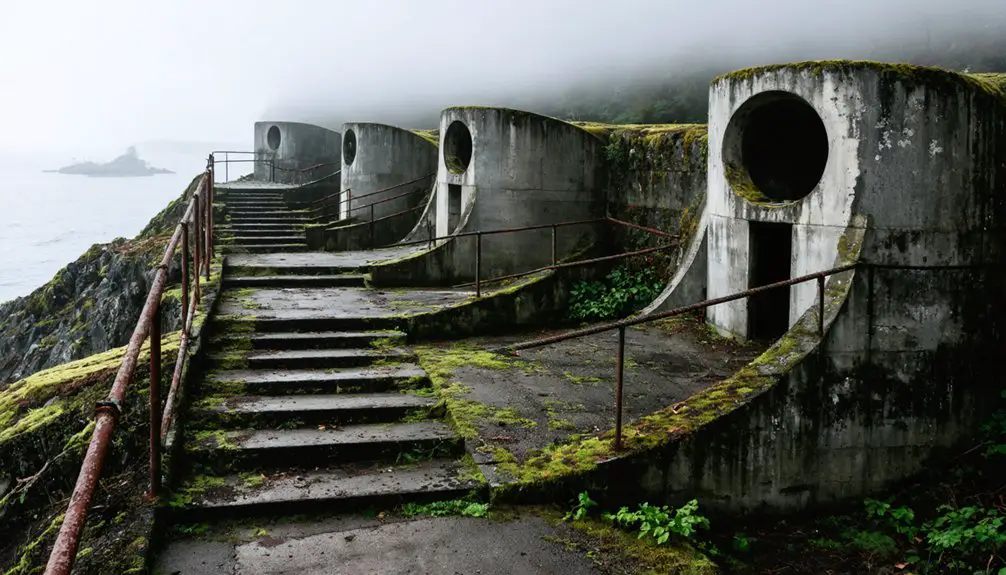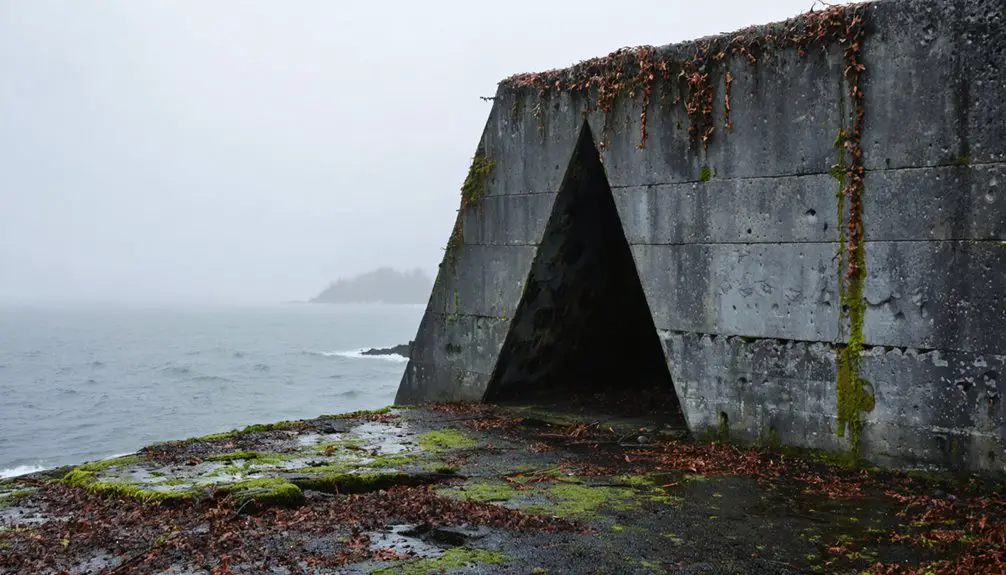You’ll discover Washington’s “Triangle of Fire” – three historic coastal defense forts built in the late 1800s along Puget Sound. Fort Worden, Fort Casey, and Fort Flagler once protected naval shipping lanes with massive concrete batteries and disappearing guns. Though abandoned since 1953, these impressive military ruins now stand as state parks where you can explore underground magazines, officers’ quarters, and artillery positions. Their silent walls hold fascinating stories of America’s coastal defense history.
Key Takeaways
- The Triangle of Fire consisted of three strategic forts – Fort Worden, Fort Casey, and Fort Flagler – protecting Puget Sound’s waterways.
- Military operations at these coastal defense forts ceased in 1953, transforming them from active bases into abandoned structures.
- Natural forces have reclaimed the abandoned military installations, with moss, plant roots, and wildlife making homes in deteriorating structures.
- The forts’ massive concrete batteries and artillery positions now stand as silent ruins, showing significant structural decay from coastal erosion.
- These former military sites have been preserved as state parks, offering visitors glimpses into early 1900s coastal defense architecture.
The Strategic Defense Network of Puget Sound
The strategic defense of Puget Sound emerged gradually in the late 19th century, driven by the need to protect essential naval assets and shipping lanes.
You’ll find the heart of this defense network in what became known as the “Triangle of Fire” – three key forts positioned at Point Wilson, Admiralty Head, and Marrowstone Island.
Congress recognized the region’s strategic vulnerabilities in 1896, authorizing $7 million for coastal fortifications to guard against sea invasions. The system protected critical naval infrastructure, including Puget Sound Naval Shipyard in Bremerton, established in 1891.
Initial construction utilized local materials while cement from Antwerp was imported to complete the fortifications. Construction of the massive concrete batteries required approximately 8,000 barrels of cement and took nearly three years to complete.
Military Engineering Marvels at Fort Worden
When construction began at Fort Worden in July 1897, you’d find the Army Corps of Engineers orchestrating one of America’s most ambitious coastal defense projects.
The military architecture showcased cutting-edge engineering, with 200 men working three years to construct eight massive batteries featuring steel-reinforced concrete and disappearing gun carriages.
These coastal fortifications represented the pinnacle of late 19th-century defense technology:
- Underground waterproof magazines protected ammunition from bombardment and weather
- Disappearing carriages concealed massive 12-inch guns behind concrete parapets until firing
- A specially-built tramway transported heavy artillery from the dock to gun emplacements
- Camouflaged positions made the batteries invisible from enemy ships at sea
The fort’s innovative design integrated 41 artillery pieces, creating an impenetrable defensive network that would help safeguard Puget Sound’s freedom for decades to come.
The fort required massive amounts of materials, including cement from Belgium shipped across the ocean for construction.
Working alongside Fort Flagler and Casey, Fort Worden formed a strategic triangle that effectively protected the entrance to Puget Sound.
Daily Life Behind the Concrete Walls
Inside Fort Worden‘s thick concrete walls, military life unfolded in a stark environment where soldiers adapted to cramped barracks, dimly lit corridors, and the constant echo of footsteps against uneven floors.
You’d find troops following strict schedules, moving between artillery drills, weapons maintenance, and observation duties in the coastal defense fortification. Fort Worden’s strategic position made it a crucial part of the Triangle of Fire from 1898 to 1917.
Living quarters reflected pure military utility – spartan rooms shared by groups of soldiers who’d coordinate their daily routines around mess hall schedules and training exercises. Coast artillery soldiers manned the fortifications continuously from 1899 to 1945.
Despite the austere conditions, you’d witness moments of camaraderie during card games and sports activities in designated recreation areas.
The maritime climate posed constant challenges, with damp air seeping through concrete and chilly winds sweeping across the bluff, while maintenance crews worked tirelessly to battle the corrosive effects of salt air on doors and equipment.
From Active Base to Abandoned Fortress
As you walk through Fort Worden’s abandoned concrete corridors today, you’ll find it hard to imagine the bustling military activity that once filled these now-silent spaces in the early 1900s.
Visitors can explore the scenic lighthouse towers that stand sentinel at each fort’s location, offering panoramic views of Puget Sound. After the last troops departed in the 1950s, the mighty gun emplacements and fortified bunkers fell into disrepair, with rust claiming the metal fixtures and vegetation creeping through cracks in the concrete. During World War II, these installations served as crucial military training centers before their eventual abandonment.
Nature has steadily reclaimed the parade grounds and defensive positions of all three Triangle of Fire bases, transforming these former military strongholds into atmospheric ruins that draw curious visitors to Washington’s coast.
Military Life Fades Away
Despite its formidable coastal defense role, Fort Worden‘s military significance began declining in the early 1900s due to rapid advancements in warfare technology.
You’d find the coastal fortifications becoming increasingly obsolete as military changes shifted from static defenses to mobile warfare solutions. The fort’s original 10-inch guns remain on display today, having been transferred from the Philippines in the 1960s. By World War I, many of Fort Worden’s heavy guns were dismantled and sent to European battlefields, marking the beginning of the end for traditional coastal artillery.
- Empty gun emplacements stand silent where massive disappearing rifles once protected Puget Sound
- Abandoned barracks echo with memories of soldiers who trained for both World Wars
- Former anti-aircraft positions remind you of the shift from naval to aerial threats
- Weathered concrete bunkers overlook peaceful waters that once needed defending
The base’s final military chapter closed in 1953, when modern warfare made the Triangle of Fire obsolete.
Decay Claims Defense Structures
Once military operations ceased in 1953, the formidable coastal defense structures of the Triangle of Fire began their steady descent into decay.
You’ll find concrete batteries crumbling from coastal erosion, as decades of salt spray and harsh maritime weather have eaten away at their foundations. The gun emplacements you’d once trust to defend the coast now show serious structural instability, with cracking walls and corroded steel reinforcements threatening collapse.
Nature’s taken back what humans built – moss blankets the walls, plant roots push through cracks, and rust consumes the remaining iron components.
The wooden barracks and officers’ quarters haven’t fared better, rotting away or falling victim to insect damage. Without military maintenance crews to fight back the elements, these once-mighty fortifications continue their slow surrender to time.
Nature Reclaims Historic Base
While military activity ceased at Fort Worden in 1953, nature quickly began reclaiming the historic coastal base on Washington’s Quimper Peninsula.
You’ll witness an impressive historic reclamation as native Douglas firs, salal, and ferns have overtaken former parade grounds and artillery placements. The wildlife resurgence has transformed this once-restricted military installation into a thriving ecosystem where deer roam freely and birds nest in abandoned structures.
- Moss and lichen colonies spread across weathered concrete bunkers
- Coastal bluff erosion reshapes the shoreline’s natural profile
- Underground tunnels harbor unique communities of moisture-loving plants
- Native vegetation softens the stark military architecture
Today, you can explore Fort Worden State Park’s blend of military ruins and natural habitats, where crumbling infrastructure provides shelter for small mammals and serves as a foundation for nature’s gradual takeover.
The Silent Guardians: Fort Casey and Fort Flagler
If you visit Fort Casey today, you’ll find massive concrete artillery batteries still standing as evidence to the once-formidable coastal defense system that protected Puget Sound’s essential waterways.
These strategic fortifications, along with their sister installation Fort Flagler on Marrowstone Island, formed two points of the “Triangle of Fire” that safeguarded Admiralty Inlet from potential naval invasions between 1897 and 1945.
The coordinated placement of disappearing guns and shared operational protocols between the two forts exemplified the sophisticated military engineering of America’s coastal defense network at the turn of the 20th century. Originally armed with 10-inch disappearing guns, Fort Casey showcased the peak of military technology for its era.
Artillery Batteries Still Stand
Standing as silent sentinels along Admiralty Inlet, Fort Casey and Fort Flagler‘s massive artillery batteries showcase the impressive scale of early 20th-century coastal defense systems.
You’ll find remarkable artillery innovations throughout these installations, including disappearing guns that could retract behind protective walls and an intricate network of powder rooms with efficient shell-hoisting systems.
- 617-pound shells moved through complex elevator systems to reach the loading platforms
- Speaking tubes embedded in concrete walls allowed crews to communicate safely
- Massive crane systems with iron rings handled 33-ton gun barrels
- Battery Commander’s Stations equipped with telescopes overlooked the defensive positions
While these coastal defense fortifications became obsolete with the rise of air power, their remaining structures tell the story of America’s determination to protect its Pacific Northwest shores during uncertain times.
Defense System Operational Legacy
During the late 19th century, Fort Casey and Fort Flagler emerged as essential components of America’s “Triangle of Fire” coastal defense system, protecting the strategic Admiralty Inlet and Puget Sound waterways.
You’ll find these forts represented the pinnacle of military strategy at the time, featuring state-of-the-art disappearing guns and concrete fortifications designed to counter modern steel warships.
Exploring the Historic Artillery Batteries

While exploring Fort Ward today, you’ll find the remnants of four strategic shore batteries that once guarded Rich Passage and its critical mine field.
These coastal fortifications showcase the pinnacle of artillery technology from the early 1900s, featuring both disappearing guns and rapid-fire weapons designed to protect Puget Sound from invasion.
Fort Ward’s artillery defenses represented cutting-edge military innovation, combining stealth and firepower to guard Puget Sound’s strategic waters.
- Battery Nash’s massive concrete structure once housed three 8-inch disappearing guns that could pop up to fire, then vanish behind protective walls.
- Batteries Thornburgh and Vinton remain accessible in Fort Ward Park, featuring parapet mounts for quick-action 3-inch and 5-inch guns.
- Two-story concrete fortifications protected ammunition magazines below while guns operated above.
- A mile-long railroad track transported heavy artillery and materials from the beach landing.
Natural Beauty Meets Military History
Beyond the concrete artillery emplacements, the Triangle of Fire forts showcase nature’s stunning beauty alongside military engineering.
You’ll discover panoramic views of Admiralty Inlet from Fort Worden’s bluffs, where seabirds soar past historic bunkers. The military ecology has evolved uniquely – those same fortifications now serve as shelters for local wildlife, with bats and birds claiming the tunnels as their own.
Through historical preservation efforts, you can freely explore trails connecting defensive positions while spotting marine mammals in Puget Sound’s waters.
The transformation from restricted military grounds to public parkland has created a rare blend of experiences. You’ll walk through coastal forests and along protected shorelines, where the strategic maritime geography that once guided military planning now offers unmatched opportunities for outdoor adventure.
Preserving Washington’s Coastal Defense Heritage

The preservation of Washington’s coastal defense heritage stands as a demonstration to innovative military engineering and historical dedication.
You’ll find impressive concrete fortifications at Fort Worden, Fort Flagler, and Fort Casey – the “Triangle of Fire” – where historical preservation efforts have transformed these military sites into engaging state parks.
- Steel breech-loading rifled cannons on disappearing carriages emerge from concealed positions
- Original officers’ quarters and barracks showcase early 1900s military architecture
- Six-inch rapid-fire guns at Fort Columbia represent rare engineering artifacts
- Interactive exhibits and guided tours bring coastal defense history to life
Through careful restoration and educational programs, you’re able to experience these strategic installations that once protected Puget Sound’s naval facilities and cities, while understanding the technological advances that eventually made them obsolete.
Frequently Asked Questions
Were There Any Reported Paranormal Activities at the Triangle of Fire Forts?
Ever wonder about ghost sightings at these military sites? You won’t find any officially documented paranormal activities or haunted history at Fort Worden, Fort Casey, or Fort Flagler despite their eerie abandoned bunkers.
How Many Soldiers Died While Stationed at These Coastal Defense Installations?
You won’t find exact soldier mortality figures for these coastal defenses, as no extensive death records exist. While soldiers trained at these forts, most Washington military deaths occurred during overseas deployments.
What Happened to the Original Artillery Pieces After They Were Removed?
You’d be amazed how those majestic guns met diverse fates – they’re either gloriously repurposed for European battlefields, mounted on naval ships, scrapped for metal, or displayed in historical artifact preservation efforts worldwide.
Did Native American Tribes Have Settlements Near These Fort Locations?
You’ll find extensive Native settlements near these forts, where Puget Sound tribes established cultural significance through permanent villages, potlatch houses, and gathering sites for hunting, trading, and ceremonies.
How Deep Are the Underground Tunnels Connecting the Gun Emplacements?
While you’d need a mountain of documentation to know exact tunnel depth, historical significance suggests these military passages likely extended 35-50 feet underground, connecting gun emplacements for efficient ammunition transport.
References
- https://www.pnwanderers.com/blog/fort-worden-historical-state-park
- https://en.wikipedia.org/wiki/Fort_Worden
- https://www.historylink.org/file/7524
- https://www.spokesman.com/stories/2021/feb/19/triangle-fire-has-been-transformed-wonderful-campi/
- https://www.youtube.com/watch?v=YJJDYKl_PZU
- https://fortwordenbook.com/fort-worden-history/
- https://www.navsea.navy.mil/Home/Shipyards/PSNS-IMF/History/
- https://www.dvidshub.net/news/544357/ssp-presents-unique-60-year-award-swfpac-partner-during-ssps-70th-anniversary-celebration-pacific-northwest
- https://cnrnw.cnic.navy.mil/Installations/NS-Everett/About/History/
- https://theclio.com/entry/1687



